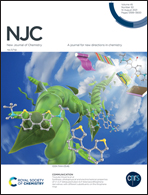A triphenylamine derived fluorescent probe for efficient detection of H2S based on aggregation-induced emission†
Abstract
Hydrogen sulfide (H2S) has an indispensable position in various physiological and pathological processes. Herein, based on the recognition strategy that uses an ortho-aldehyde group to facilitate the thiolysis of dinitrophenyl ether, a new fluorescent probe TPA-HS based on triphenylamine derivative was synthesized to detect H2S. The probe is slightly soluble in THF/H2O (2/8, v/v, HEPES 20 mM, pH = 7.12) solution, and reacts with H2S to release its precursor TPA-CHO with aggregation-induced emission properties, and realizes the fluorescence “turn on” type response. TPA-HS can quickly and efficiently detect H2S within 20 minutes, and the detection limit is as low as 7.63 × 10−6 M. Importantly, the probe has been successfully used to detect H2S in real water samples and living MCF-7 cells.



 Please wait while we load your content...
Please wait while we load your content...